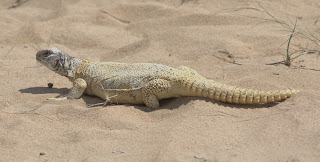 |
| Arabian Oryx |
Following a visit to Ghana (the next six posts on this blog), Bill Watson and I had two days in the United Arab Emirates to break the journey home – 23-24 April, 2023. We stayed in the Ibis One Central Hotel in Dubai. On the first day I headed south to Kite Beach and Al Sufouh Beaches to look unsuccessfully for Socrota Cormorant, but had to make do with some interesting sights as an introduction to the UAE.
We hired South African-born local businessman and wildlife enthusiast Gary Burns for a full-on outing for our second day, crossing the country twice in search of a handful of target birds and mammals, and to see more of the UAE. We highly recommend Gary’s services for anyone considering something similar in this country: contact him here.
 |
| Gary Burns |
We left early in the morning, heading east from Dubai on the road to Kalba, driving about 1.5 hours to reach our first destination, Wadi Alrawasi. This is a classic desert wadi, a kind of low sandy area, much of it dry creek bed, wedged between rocky crags. One of the first birds we saw was Arabian Babbler, a flock of 4 and one of the targets. Another target, the recently split Arabian Green Bee-eater, put in an appearance.
 |
| Arabian Babbler |
Desert Larks were common.
Soon after I spotted a Sand Partridge racing up a scree and two birds flushed. We were impressed with how Gary’s formidable 4WD, specially fitted out to accommodate the tough desert conditions, negotiated the rugged terrain in the wadi.
 |
| Bill & Greg |
 |
| Wadi Alrawasi |
Other birds showed nicely including the tail-wagging Eastern Olivaceous Wartbler and Rufous-tailed Scrub-Robin.
 |
| Rufous-tailed Scrub-Robin |
We moved on to a nearby second wadi, Wadi Tuwa. where we located a small covey of Sand Patridges that offered better views.
 |
| Sand Partridge |
Distractions included an Indian Roller eating a substantial lizard and a dazzling Purple Sunbird.
 |
| Purple Sunbird |
We located another target, Humes’s Wheatear, on the scree slopes, and found two more wheatears on roadside wires as we left the wadi. Scrub Warbler and Rufous-tailed Rock-thrush were among the birds here.
 |
| Humes's Wheatear |
We continued
eastwards to the Indian Ocean at the port of Dibba on the border with
Oman, having crossed the country. Here we scrutinised various inlets
and bays in search of Socrota Cormorant, finally connecting with a
sub-adult on rocks at the entrance to the fishing harbour.
Unfortunately the bird was in a military zone and we were not allowed
to photograph it.
 |
| Dibba |
We drove west and
then south to the Al Marmoon Reserve in the Al Qudra Desert. Soon
another target showed in the form Black-crowned Sparrowlark, of which
there were plenty among the white sand dunes.
 |
| Black-crowned Sparrowlawk (f) |
 |
| Black-crowned Sparrowlark (m) |
We went for quite a
wild and spectacular drive through the dunes, assured that
Gary knew what he was doing.
 |
| Al Qudra |
We found a gorgeous Pharoah’s Eagle-Owl, a bird I’d seen previously in Morocco and one of the more impressive owl species.
 |
| Pharoah's Eagle-Owl_ |
We also saw our first Sand Gazelles and Arabian Desert Gazelles, along with the impressive Egyptian Spine-tailed Lizard (below).
We moved to another section of the desert as the afternoon wore on, this time in an area where red sand dunes prevailed. An artificial wetland had a few waterbirds including good numbers of Greater Flamingo.
 |
| Greater Flamingo |
Greater Hoopoe-Lark (below) was looking good here.
We headed further into the Al Qudra, getting much better view of both Sand Gazelle and Arabian Desert Gazelle, which were about in good numbers.
 |
| Arabian Desert Gazelle |
 |
| Sand Gazelle |
We then enountered a single Arabian Oryx, by any standard an impressive beast, and later watched a small herd of these endangered animals. The species was once declared extinct in the wild but it has been successfully reintroduced to some of its former strongholds , including the Qudra Desert.
 |
| Arabian Oryx |
Less spectacular but still cute was the distinctive arabicus race of the Cape Hare (below).
We returned to our hotel in the late afternoon, where we celebrated by downing a few horrendously expensive beers in this alcohol-adverse country. It was a great day out!







No comments:
Post a Comment